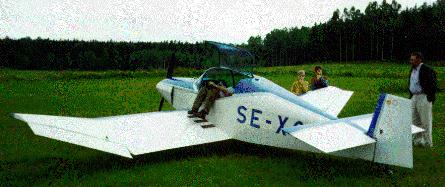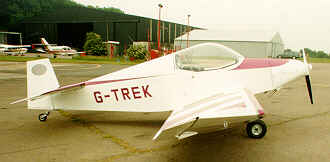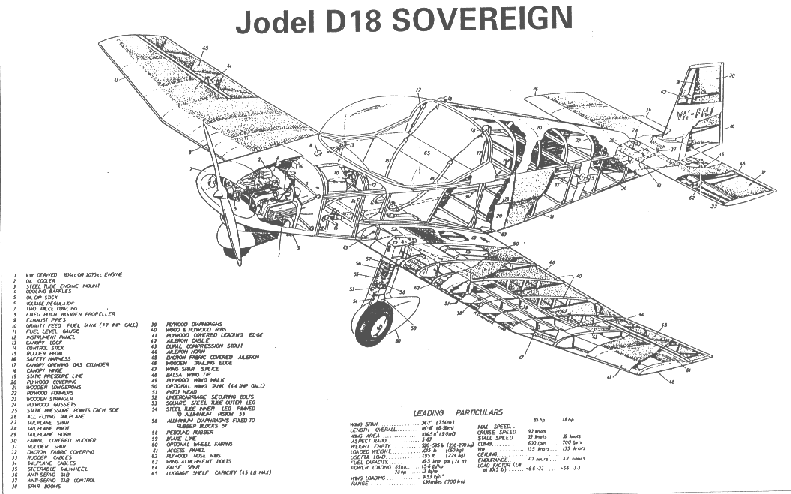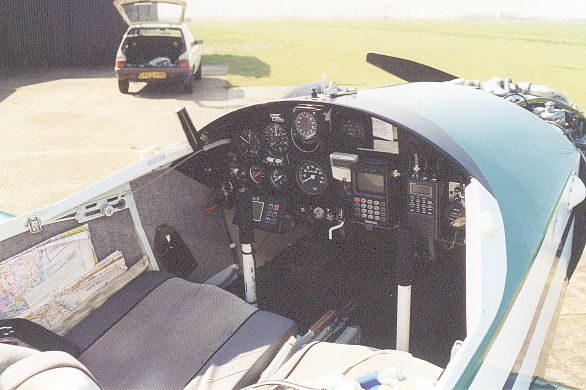
The DC1/D18/19/D20
DC1
M. Alain Cauchy approached M. Delemontez after the 1973 oil crisis wanting to revive the D-11 concept, this time aiming to get the most out of a converted VW engine. The resulting two-seater was named DC1, after Delemontez and Cauchy. After roughly 5000 hours of design, engineering and building the DC1 took to the air for the first time in 1978. The plane is indeed much more related to the D9 than the D11. Major changes are that it has a more modern wing profile, and the fuselage is wide enough for two.
The resulting plane is really impressive. With an empty weight of only 216kg its gross weight is 450, another Jodel with payload capacity bigger than it's own weight! With a 1600cc converted Volkswagen engine the cruise speed is 170km/h, and fuel consumption 11l/h.
D18
The success of the DC1 lead M. Delemontez to make a thorough revision, and the first D-18 took to the air in the spring of 1984. At first glance looking quite similar to the DC1, there is hardly a single point where Delemontez has not checked, thought and more often than not, changed something. The prototype has a slightly bigger span than the DC1, and weighed 243kg empty. MTOW is 460kg.
 Swedish homebuilt D18, built by Henry and Olav Nyberg |
In the 13 years that passed between the prototype's first flight and the summer of '97, SAB had sold approximately 470 licences. This should mean about 35 sold pro year. And if you use EAA's statistics saying about 15% of homebuilts are completed it should mean about 70 are currently flying. The straightforward construction of the plane should indicate that more of them are flying however. Like all other Jodels the D18 is built entirely of wood. Even compared to other wooden airplanes there is incredibly little metal in a D18. Beside the engine most of the metal is in the undercarriage. |
Primarily aimed at being powered by a 1700cc Volkswagen conversion, the D18's are powered by a multitude of powerplants. Different VW conversions, Limbach engines, JPX'es of different sizes and last but not least the Australian Jabiru engine. Rotax 912/914 should also be good engines for the D18.
D19
As the D18 has a classical undercarriage and many clubs like a nosegear for their planes, M. Delemontez came up with a variant of the D18 called the D19. Beside the nose wheel, the main difference to the D18 is the flap. The flap drawings contain information for putting a similar flap on the D18, and is a classical Jodel flap of narrow chord. It is not very effective as a high lift device, but a very useful brake on landing. The drag of the nosewheel does degrade the performance to some degree, but on the other hand ground handling is made simpler - adding up to the well known good handling qualities of all Jodels.
 Award winning D18 G-TREK, built and owned by Richard Mole. Richard has flown G-TREK to the North cape and back, just prior to the Cranfield '96 Rally. |
Plans for both planes are available through S.A.B. Same firm also sell a multitude of bits and pieces for the aircraft, like hinges, horns, undercarriage assemblies, perspex cockpit canopy, controls and engine mounts. But when it comes to wood you are on your own! These are definitely home builts and not kit planes. Having said that, I haste to add that the D18/D19 is a relatively simple project in its category, compared for instance to the Piel Emeraude. M. Delemontez has skeched around 800 working hours. I would rather believe around 2000 - at least that if you have no previous experience in plane building. |
What should really add to the D18/19/20 family's popularity are the new Ultralight rules now being almost universally adopted throughout Europe. They call for a MTOW of 450kg, and that should fit the D18/19 MTOW of 460kg just fine. The stall speed seems a different cup of tea. Same regulations say an ultralight should be able to fly at 65km/h. This is hard to attain with a D18 or 19, but should be possible with a high-lift flap.
D20
The last Jodel from M. Delemontez' hand is the D20. The wing from the D19 is married to a completely new fuselage resembling the shape of the Robin-Jodels. Plans for the D20 are not generally available. Instead S.A.B. do all the woodwork, and it can be bought from them in a ready-to-cover state. Designed from the outset to utilize a JPX 85hp engine, the little two-seater is a great performer just as the D18 and 19.
The aircraft is available in Normal and Microlight kit form, and is delivered in either trigear or taildragger configuration, depending on the customer's preferences.

Exploded view of the D18.This is the Australian version, nicknamed Sovereign
Click on the picture to get a large version.
The following table summarizes the performance specs of the different models:
| Plane: | D112 | DC1 | D18 | D19 | D20 |
| Wing span: (m) | 8,20 | 7,40 | 7.50 | 7.50 | 7.50 |
| Lenght: (m) | 6,26 | 5,65 | 5,70 | 5,70 | 5.80 |
| Height: (m) | 1.93 | ||||
| Wing area: (m2) | 12,70 | 9,56 | 10 | 10 | 9.93 |
| Cabin width: (m) | 1,0 | 1,0 | 1,12 | ||
| Fuel capacity: (L) | 65 | 65 | 100 | ||
| No. of seats: | 2 | 2 | 2 | 2 | 2 |
| Engine: | |||||
| Type: | Continental | VW 1,6 l | VW 1,7 l | JPX 1,835 l | JPX 4TX75 |
| Power: | 65 | 52 | 58 | 70* | 85 |
| At RPM: | 3000 | ||||
| Weight: | |||||
| Empty weight: (kg) | 320 | 216 | 245/255 | 244 | 250/260 |
| Max weight: (kg) | 530 | 450 | 460 | 460 | 500 |
| Performance: | |||||
| Max speed: (km/h) | 240/250 | ||||
| Cruise speed: (km/h) | 160 | 170 | 175 | 200/220 | |
| Climb (2p): (m/s) | 3,0 | 3,5 | 3,5 | 3-3,5 | |
| Range: (km) | 1500 |
* Calculated. Information stated "20% more than the D-18".
So there we are - 4 new variations on what is a more than 50 years old theme. Not very much changed since the first Jodel, but most Jodels still have a performance that equals, or even betters newer planes. So that's another good reason that we'll keep building new Jodels for a long time to come.
Ultralight
|
As the Ultralight specifications changed during the 1990's, many builders (me including) realised that it should be possible to register a D18 as an U/L with only minor modifications. These rules even seem to have been harmonised throughout Europe - at least to some extent. SAB also seems to have seen this as a new marketing niche. In late 1999 a brochure emerged telling about these recent Jodel developments. |

|
The new variants are called D185 and D195, and differ from their D18 and D19 forerunners in the following way:
- 8 cm wider, more comfortable fuselage.
- Hood extended towards the rear, opening by sliding the rear part rearwards.
- Flap of increased area (which means increasing wing area as well) to lower the stall speed. The increase in area is simply done by stretching the TE of the flap rearwards by 100mm, leaving the wing unchanged. The flap is also extended all the way to the root rib.
- Hydraulic springs (oléopneumatique) in the undercarriage.
- Gross weight reduced to 450kg.

|
The rearwards extended hood makes installing the 65l fuel-tank behind the seat the only option left. The brochure lists the specs. of the planes to be very similar to their ancestors. A stall speed of only 60km/h sounds a little optimistic however - at least at gross weight. The engines that are used for the D18/D19 are also listed as suitable for the ultralight variants - VW1600 - 1800, Rotax 912, JPX, Limbach and Jabiru. Rumours say that the D20 has been developed in a similar way. |
Many thanks to D18 builder and club member Erik Eldegard for writing this page
Author Hans Teijgeler
The photos in this web site are from the excellent book by Xavier Massé,
sent in by happy Jodel owners, lifted from the web or taken by myself.
